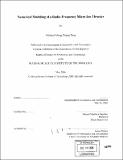Numerical modelling of a radio-frequency micro ion thruster
Author(s)
Tsay, Michael Meng-Tsuan
DownloadFull printable version (13.82Mb)
Other Contributors
Massachusetts Institute of Technology. Dept. of Aeronautics and Astronautics.
Advisor
Manuel Martinez-Sanchez.
Terms of use
Metadata
Show full item recordAbstract
A simple performance model is developed for an inductively-coupled radio-frequency micro ion thruster. Methods of particle and energy balance are utilized for modeling the chamber plasma discharge. A transformer model is incorporated in the equations of energy balance for investigating the effect of plasma on the primary circuit and for calculating the absorbed power by the plasma. A simple and one-dimensional ion extraction model is developed based on experimental observation and the result is validated with experimental data. Performance of the RF micro ion thruster is satisfactory with thrust and specific impulse of approximately 2 mN and 2000 seconds, respectively. Comparison is made with a miniature bombardment-type ion thruster, and the RF ion thruster is found to be more efficient when the coupling efficiency is above 80%. Optimization in driving frequency increases power absorption and ionization fraction tremendously. It has a positive but limited effect on propulsive performance as the ion beam current is space-charge limited.
Description
Thesis (S.M.)--Massachusetts Institute of Technology, Dept. of Aeronautics and Astronautics, 2006. Includes bibliographical references (p. 113-114).
Date issued
2006Department
Massachusetts Institute of Technology. Department of Aeronautics and AstronauticsPublisher
Massachusetts Institute of Technology
Keywords
Aeronautics and Astronautics.